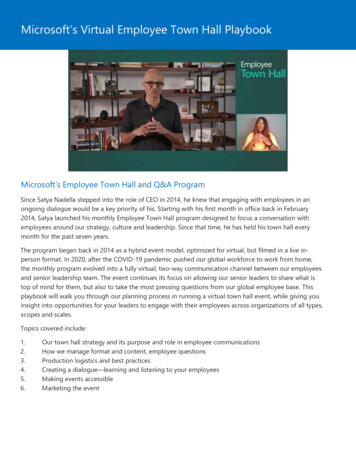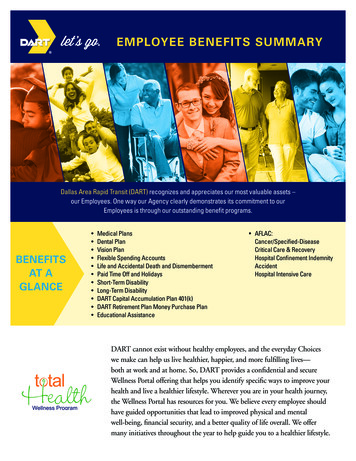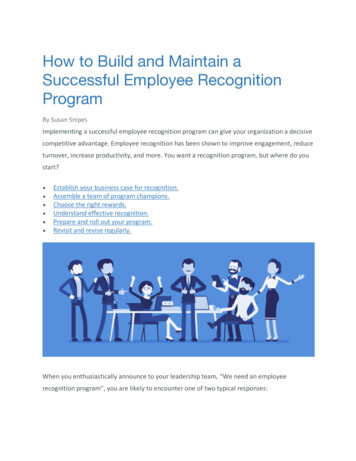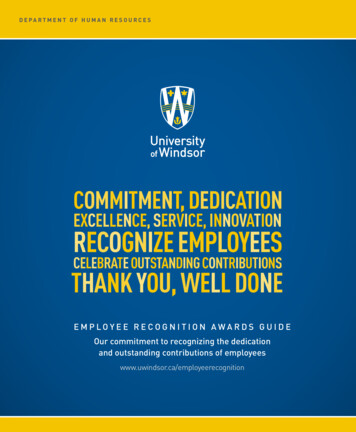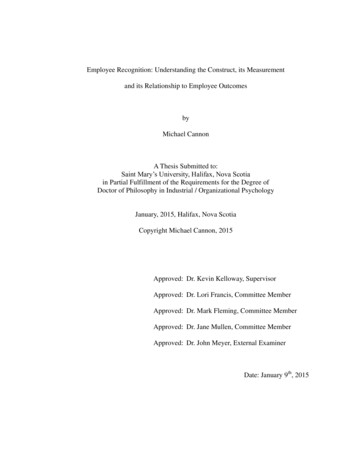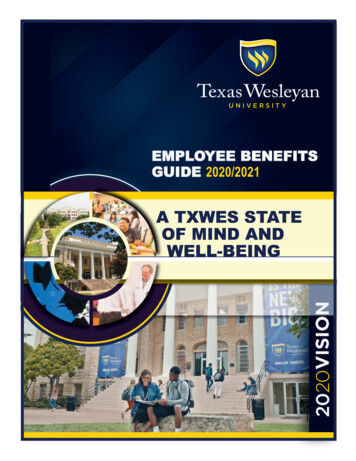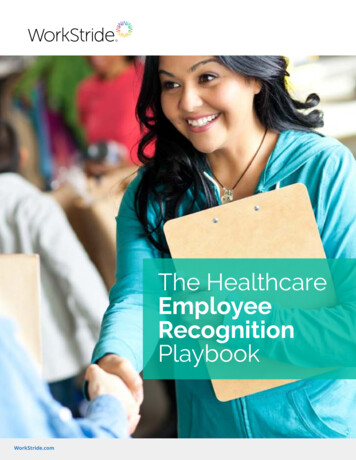
Transcription
RThe m
SummaryOrganizations are only as effective and successful as their employees, and nowhereis this truer than in healthcare. People who choose to work in the healthcare fieldare, by nature, caring, compassionate individuals who are devoted to helpingothers. Retention of these invaluable employees is critical, yet that is no simpletask — especially since the onset of the COVID-19 pandemic. Cases of burnout havebecome far too common, and turnover is extraordinarily high. Perhaps more thanat any other time, healthcare employees at all levels need to know they are valuedand appreciated. Of the many ways this can be accomplished, formal employeerecognition programs are some of the most valuable.In this Employee Recognition Playbook, we will cover the following:Contents3 Why Recognize?Why employee recognition is so important7 Objectives – The CARES ConceptHighly successful healthcare recognition programsoften contain five key points:Celebrate, Acknowledge, Reward, Engage, and Survey9 Successful Strategies for Hospital RecognitionHow to put the CARES concept to work for yourhealthcare organization14 Results – Measuring SuccessIndicators of a program’s effectiveness17 Optimization – Good to Great MethodsThe top five factors to ensure consistent, increasing successof your recognition programs19 A Few Final WordsWorkStride.com2
About WorkStrideWorkStride serves enterprise companies as a leading provider of reward andrecognition programs within the healthcare sector. Our blend of award-winningtechnology, expert consultative design service, and industry-leading support haspositioned WorkStride as a top provider and subject matter expert in healthcarerecognition and patient satisfaction. With more than 150 enterprise healthcareclients, like Advocate Aurora Health, Orlando Health, Cleveland Clinic, AETNA, andCone Health, WorkStride has cultivated a wealth of insight into the unique nuancesof what makes recognition successful within the modern healthcare system. Welook forward to sharing some of that insight with you through this resource.Why Recognize?People Need RecognitionCompanies throughout the world have learned the extraordinary valueof employee recognition programs to reward and retain their staff, aswell as to attract new employees. Within the healthcare industry, wheresuccess is largely dependent on the quality of care provided by staff, thesignificance and impact of recognition becomes even greater.Today, healthcare networks face unprecedentedchallenges, including hospitals filled to capacity,rising demands for quality of care, and limitedresources — while at the same time grapplingwith historically low operating budgets andcosts that continue to rise. Although enhancingemployee recognition is by no means a cure-allfor these formidable challenges, more and moreleading hospital systems are adopting formal programs in an effort toretain employees and keep productivity flowing.WorkStride.com3
SATISFIED CAREGIVERS MEANS SATISFIED PATIENTSThe purpose of caregiver recognition is not only to support staff, but also patients — and thetwo goals are closely aligned. The quality of care provided to patients depends on engagedand motivated caregivers. While regular interactions with patients can be rewarding formany healthcare workers, the stressful nature of the work can still wear them down. This isespecially true in times of heightened capacity and sudden surges, which may require moreintense care without additional resources.Caregiver satisfaction directly affects quality of care. A typical 15 percent increase in patientsafety occurs when a healthcare team is highly engaged. This has a direct impact on patientsatisfaction — and that, in turn, has a direct effect on HCAHPS ratings.Credit: Kevin Kruse, ForbesTHE HARSH REALITY OF BURNOUTThroughout the COVID-19 crisis, healthcare employee burnout became a majorissue. Most everyone in healthcare was affected by this, but nurses were hitespecially hard. Surveys have shown that during the height of the pandemic,nurses experienced an increase in emotional exhaustion, feelings ofdepersonalization, and a lack of personal accomplishment, leading to lowerproductivity levels.Dr. Redonda Miller, president of Johns Hopkins Hospital, says nurses workedextended shifts, sometimes working 24 hours a day in uncomfortable personalprotective equipment, while worrying about their own exposure to COVID.He says that making sure healthcare employees know how valued andappreciated they are can help them cope with the stress of their jobs andpossibly avoid burnout. As Miller said during a U.S. News webinar:“It’s not the sole answer — I know that — but it helps.”WorkStride.com4
THE HIGH COSTS OF HEALTHCARE TURNOVERHealthcare market analysts at Becker’s Hospital Review report that turnover in the healthcarevertical is bad, with only hospitality being worse. This problem comes with a cost. Physicianturnover alone can reach as high as 1 million per role, according to an article in RecruitingPhysicians Today.The average cost of turnover for a bedside RN is 40,038.This results in the average hospital losing between 3.6m – 6.5m per yearto churn replacement cost.Volume 20 No. 3 May/June 2012An advertising service of NEJM CareerCenterinsidethis issueunderstanding theReal Costs of Recruitingand Retaining PhysiciansPages 1–3market watchPage 3what’s newat nejm?NEJM ReleasesiPad App!Page 3promotionalnotes/newsReach Top Residents,Fellows, and NewPhysicians!Page 4upcomingrecruitermeetingsand medicalconventionsPage 4Understanding theReal Costs of Recruitingand Retaining PhysiciansSource: Lori Schutte, MBA, president of CejkaSearch, a national physician recruitmentand executive search firm serving health careorganizations exclusively for more than 30 years.Today’s physician recruiters must jugglehigher costs of turnover and tighter budgetsfor recruitment in addition to the everpresent challenges of finding, hiring, andretaining well-qualified physicians who willfit well and thrive within an organization.In an industry increasingly driven byevidence-based outcomes, it is important tounderstand the real costs of an inefficienthiring process and physician turnover.Actively managing hiring and turnover willlower the risk of lost revenue due toprolonged vacancies, increase control overhidden drivers of recruitment costs, andbuild a business case for retention initiatives.While it may be counterintuitive to medicalgroups that successful hiring rates canincrease as the number of interviewsdeclines, a health care organization canachieve significant improvement in hiringefficiency and results over time by (a)increasing the effectiveness of pre-interviewcandidate screening, and (b) engineering theinterview process to culminate with a timelyand competitive offer to the right candidate.Turnover Today — The LandscapeAs the Cejka Search and American MedicalGroup Association 2011 Physician RetentionSurvey reports, on a combined, adjustedbasis, there was little change in overallphysician turnover from 2010 (6.1%) to2011 (6.0%).*However, the 2010–2011 static turnovertrend appears to track with general conditions in the economy and housing market.The 2008 retention survey indicated that aworsening economy and plummeting homesales were causing physicians to delayretirement and relocation, which are keydrivers of turnover. A decline in the turnoverrate in 2008 and 2009 was followed by anuptick in 2010 and maintained at that level in2011, tracking modest economic recoveryand leveling declines in the housing market.Current improving investment and real estatevalues may signal a return to higher turnoveras more physicians retire or relocate.The Business Case for EfficientRecruitment and RetentionThe consensus from the medical groupsresponding to the 2011 retention surveyindicates that hiring of physicians andadvanced practice providers will acceleratethrough 2012. Nearly three-quarters (74%)of the responding groups reported that theywould hire more or significantly moreprimary care physicians in the next 12months than they did in the prior year.A more competitive market can drive up costsand the time required to fill vacancies,fundamentally linking retention and recruitment. Groups that invest in hiring for culturalfit, invest in a proactive retention program,and maintain an efficient process will be wellpositioned in an increasingly competitiveenvironment.The on-site candidate interview, a key step inrecruitment, can become the single largestdriver of expense when valued for hard costs,recruiting team time, and lost revenue dueto the position vacancy, which increases asthe interview process is protracted.(continued on page 2)sponsored by PracticeMatchDOWNLOAD REPORTHospital employee turnover rates have increased and are significantly higher than in otheroccupations. While turnover rates of different roles within the healthcare sector vary, manysignal dramatically high rates, with some roles edging over 35 percent. According to the U.S.Bureau of Labor Statistics (BLS), the average turnover rate in the U.S. is about 13 percent —which places healthcare in dramatic terrain.Some specific examples: Turnover rates for certified nursing assistants (CNAs) have recentlybeen 27.7 percent; physician assistants (PAs) have seen a 14.2 percent turnover rate; and theturnover rate for patient care techs (PCTs) has been 19.3 percent.The lack of recognition and engagement contributes significantly toemployee turnover. According to the Society for Human ResourceManagement, at least 90 percent of HR professionals believe recognitionand reward influence employees to stay in their jobs.ATTRACTING STAFF IS MORE IMPORTANT THAN EVERAlong with efforts to retain employees, healthcare systems must make a concerted effortto attract new employees — and in today’s competitive healthcare market, that is especiallychallenging. Employment opportunities for nurses are projected to grow 15 percent fasterthan all other occupations through 2026 — which the BLS says will warrant roughly 11 millionadditional nurses in the market to avoid a shortage.According to the American Nurses Association, there will be moreregistered nurse jobs available through the end of 2022 than any otherprofession in the United States.WorkStride.com5
It behooves leading hospital systems to invest in becoming more attractive to talentedemployees in a competitive marketplace. Part of this means understanding the concernsthat are prevalent with healthcare candidates — including a lack of recognition andappreciation. Formal employee recognition programs can help alleviate this concernamong potential job candidates.One of the leading causes of employees transitioning to a similar role at anew organization involves a lack of recognition and appreciation. Gallupreports that those who claim to be engaged at work make up only about30% of theoverall workforce.WorkStride.com6
ObjectivesThe CARES ConceptOnce the need for a recognition program is established, where do youbegin? From group outings to bonus days off to employee of the monthdesignations to special appreciation events, there are innumerableways to let employees know they are valued and appreciated. Interms of formal recognition programs, we suggest thinking in termsof CARES: Celebrate, Acknowledge, Reward, Engage, Survey. These arecornerstones of some of the most successful employee recognitionprograms in EENGAGEREWARDWorkStride.com7
CELEBRATEENGAGEProviding an environment where activitiesMore than periodic acknowledgement,can be shared, celebrated, and reinforcedemployees need a continuous stream ofin a communal setting raises morale andengagement that can include recognition,contributes to a more inclusive culture.as well as other forms like, communication,ACKNOWLEDGESpotlighting individuals for their specificbehaviors is a core component of anysuccessful recognition program. When abehavior is recognized by a peer, manager,or patient, the employee is motivated toperform even better.REWARDtraining, cultural activities, andencouragement of social interaction amongpeers.SURVEYPromoting a positive culture and workplaceis more than doing; it’s also encouraging andlistening to what employees say. By collectingand analyzing their feedback, employersSurveys have shown again and again thatlearn what employees think could be doneemployees believe management shouldbetter to ensure their success and happinessreward them for a job well done when theat work. Feedback provided in surveysparticular action occurs. This encouragesdirectly correlates to employee engagementfuture behaviors that align with rewards.and to the success of recognition programs.WorkStride.com8
StrategySuccessful Strategies for Hospital RecognitionSo how can you put the CARES concept to work for your healthcareorganization? WorkStride has studied some of the country’s leadinghealthcare systems and learned how they manage recognition,engagement, retention, and attraction within their organizations. As youreview the following initiatives that are common in leading recognitionprograms, you’ll notice CARES factors woven in.MILESTONES ANDACHIEVEMENTSREWARDABLECHALLENGESFEEDBACK COLLECTIONAND TRACKINGHOLIDAYS AND RAMFEEDBACKSOCIAL RECOGNITIONAND ENGAGEMENTPATIENTSATISFACTIONMILESTONES AND ACHIEVEMENTSThe cornerstone of a successful healthcare recognition programis the nomination, acknowledgment and reward of organizationalachievements. While traditional milestones recognized in mostorganizations align with tenure (commonly referred to as ServiceAwards), great engagement programs go further; they incorporatemore opportunities to recognize individual and team behaviors thatoccur on a daily basis throughout the organization.Service AwardsService Awards programs are a long-standing part of recognition programs at leadinghospitals. Years of service within healthcare is a great value to the organization, asreplacement costs and burdens for employees can be extreme. While not all employeesstick around for the long haul, large hospital systems do see some highly tenured staff —WorkStride programs have recognized some folks with more than 50 years on the job. So it’simportant that great tenure is recognized and even showcased if appropriate.The design for Service Awards should go beyond tiers; it should be exciting and engaging.Sometimes there are creative names, themes, or specific award titles for each level.Rewards relevancy is also an important factor to consider in Service Awards. For example, a50-year employee will expect a bit more than a certificate or virtual recognition compared witha five-year employee. A mix of both values and reward types can be considered (e.g., plaques,WorkStride.com9
trophies, pins) and/or monetary value in the form of payroll, gift cards, or Visas.REWARDABLE CHALLENGESWith a formal recognition program, any behavior the organization wantsto recognize can be supported. From the use of non-monetary thank youawards to monetized awards spotlighting specific behaviors, our platform isflexible and supportive.Most of our healthcare clients have created a balanced award structure. This enables peers toshow gratitude toward each other on a daily basis, and also incorporates a blend of awardsthat offer small monetary incentives for achievements such as above-and-beyond efforts, anincrease in patient satisfaction, and positive patient feedback, among others.Challenges can be simple or rather complex. Consider getting advanced with custom rulestructures, audience segmentation and personalization, and dashboards/leaderboards tostream results in a fun and interactive manner.HOLIDAYS AND SPECIAL OCCASIONSIt’s important to employees that organizations acknowledge and celebrate special occasions.These celebratory activities offer hospitals an opportunity to thank staff for all their hardwork, and can create a stronger sense of community within your organization.Within WorkStride client recognition programs, many hospitals leverage holidays as well asWorkStride.com10
employee birthdays as opportunities to show appreciation to employees.Recognizing employees with a holiday or birthday gift is a common practice within ourhealthcare programs. The platform allows a seamless, efficient solution in support of thesespecial, and meaningful gifts.Additional gifting opportunities that are common in our healthcare recognition programsinvolve important industry designations, such as Nurses Week, Healthcare EmployeeAppreciation Week, and others.SPOT RECOGNITIONIt’s also important to highlight regularoccurrences within an organization; althoughthis often happens behind the scenes, it iscritical to the development of a recognitionculture. Normal recognition for great activitieshelps foster a highly engaged culture,and creates the likelihood the recognizedemployees will repeat the positive behavior.During the pandemic, some of our customersused our platform to send Uber Eats andStarbucks to facilitate remote team lunchesSpot Recognition awards give managers (and in some cases peers)the ability to immediately recognize employees for staying late,covering extra shifts, or other above-and-beyond efforts.WorkStride.com11
and coffee breaks.SOCIAL RECOGNITION AND ENGAGEMENTIn the not-so-distant past, all recognition and engagement programs were “offline” since“online” didn’t yet exist. Today, software has modernized recognition programs to add asocial media-like experience — without the ubiquitous memes and fiery political posts.Social Recognition refers to the peer-to-peer nature of a recognition program. It allowsemployees to share in the recognition of their peers by liking and commenting on theirrewards. Many of WorkStride’s client programs use Social Stream, which enables employeesto acknowledge and engage with one another on a daily basis. These daily interactions createa sense of community that can sometimes be lacking in organizations where campuses aregeographically distant.FEEDBACK COLLECTION AND TRACKINGThere are myriad ways to assess and improve a company and its culture, and collectingemployee feedback is one of the most effective ways to start. You can incorporate questionsinto your employee survey, employee reviews, new hire training, and/or manager trainingon what they want to see in a recognition program. This will lay the groundwork for theorganization to understand how to make the program successful.Tracking results will be critical to the evolution of your program, and our reporting suite willgive you access to all program activities. Identifying lags in usage by department, role, andfunction gives insight into challenges within a specific segment.One of our WorkStride clients used our reports to identify a training issue with English asa second language employees. They didn’t know how to log in to the platform because thetraining communications were hosted in English. Our reports showed that these employeesWorkStride.com12
had received recognition but were unableresult in a meaningful list of improvements toto log in; once identified, the organizationtackle with your team and program provider.was able to pinpoint the individuals andAn important measurement in determiningcommunicate directly with them.the success of your recognition program isChallenges occur within organizations,creating a baseline. If only 20 percent of yourand often they get missed. Intuitivepopulation feel they are being recognized,reporting gives you insight andwe can work together to track and increaseopportunities to identify andyour scores. As your partner in recognitionsurmount those hurdles.through data sharing and collaboration,we can create a recognitionEMPLOYEE SURVEYSprogram that exceeds yourSurveying employees is a criticalemployees’ expectations.component for improving culture. Feedbackcan illuminate challenges and fuel positivePATIENT SATISFACTIONchange and greater employee satisfaction.Gathering feedback from employees canHowever, it can be challenging to convincebenefit them, while gathering patientbusy staff to participate. Catching employeesfeedback can improve the patient experience.when they are in the right mindset helpsAfter all, the ultimate goal of every healthcareto ensure a good response rate. You canprovider is to offer the best possible care toleverage your recognition program bypatients.incorporating communications aroundReaching out to patients and asking themsurveys, reminders, or even pulse surveyswithin the program design.about their experience is critical to howa recognition program’s structure willFor a more comprehensive surveybe developed and utilized. High-scoringstrategy, you can conduct an internalpositive patient experience pays dividends.survey campaign with the employee base.Positive patient satisfaction ratings leadWorkStride provides this to clients as anto higher reimbursement levels fromadded service offering in order toinsurance providers.ensure that employee attention iscaptured.PROGRAM FEEDBACKFeedback on the company, culture, andBy giving patients a voice and allowingleadership is incredibly valuable. Butthem the opportunity to recognize theremember to ask about your recognitioncaregiver(s), custodian, nurse, or valetprogram itself; do employees feel it’s usefulparking attendant who made theirand simple to use? Are the rewards inspiring?experience rewarding, the moment isThe insight directly from program users canexperienced, recognized, andWorkStride.com13
ResultsSuccess MeasurementMeasuring success is a must for modern recognition programs. Successextends beyond the obvious program activity and into performanceindicators to the overall company and culture; like retention, employeesatisfaction, patient satisfaction, and productivity, among others.There are two important key categories of value that every healthcareleader should consider as they think about what success looks like: resultsin the form of creating value and results in the form of saving cost.VALUE CREATIONMeasuring the value of a recognition program is an exercise of determining what performance indicators are showing an increased result compared to the past, and what positiveattributes exist that were not there before.Engagement / ProductivityOne of the most common ways of assessing the success of a recognition program is measuring engagement. Often, this is a bit of a wild goose chase, as “engagement” is a rather nebulous concept. What is it? And how do you measure it?The answer is there are many answers. Engagement could be program usage like loginsor recognitions sent. Engagement could be a qualitative buzz in the culture and feelings ofimprovement. And engagement could be productivity and measures of patient output andsatisfaction. While there is no right answer in how “engagement” is defined, it’s important toconsider both the “leading” indicators and “lagging” indicators.Leading indicators of engagement are activities that can lead to future movement toward aresult. For example, more program recognitions sent will likely lead to more engagement withinthe culture. Also important, however, are the lagging indicators, which measure the results ofthose leading actions. These indicators can be seen and measured in program activity data.Lagging indicators are the output — factors such as qualitative feedback (words that expresswhether things are or aren’t working well) or measured productivity (actions that representgood business health, like the number of patients seen or tasks completed).Organizations that measure up to highly engaged employees report up to22 percent higher productivity than ones that don’t.WorkStride.com14
Patient Satisfaction and HCAHPSAnother force of quality measurement within a healthcare system is contained in words fromthe patient. Direct links are made between healthcare company culture and patient experience. So, if patient experience is measuring high, it indicates that the staff providing themwith good service has healthy work engagement.While hospitals often conduct their own patient satisfaction research, there is also of coursethe national standardized version of HCAHPS. It serves as an instrument to collect feedbackfrom patients on their hospital experiences and publish a resulting rating for public visibility.These scores impact a hospital’s bottom line in two ways. One is a low score potentially damaging the reputation of a hospital among future potential patients and employment candidates. The other is even more direct in financial impact, as low HCAHPS scores can limit theamount of funding received from Medicare.Measurements of your company’s feedback, ratings, and scores tell you (often literally) howsuccessful the endeavors of cultural engagement are going.Talent AttractionSuccess in cultural improvement can be measured by how much talent your organizationis attracting and retaining. Great, engaged cultures result in good word of mouth, positivepress, and employee referrals to their contacts. One effective way of keeping a pulse on improvements is measuring recruitment KPIs. How many candidates are filling out applicationsfor new job postings? How quickly are those jobs being filled?These drivers can tell an impactful story about your organizational culture, and improving theresulting overtime can showcase positive cultural change. Another important indicator is howmany times these high potentials are being recognized. One study reported that 75 percentof high potentials were more likely to be retained if they had received recognition; it didn’tmatter what type or level of recognition they received, only that they had been recognized.COST SAVINGSAssessing organizational cost is the otherside of success measurement. Unlike valuecreation, which assesses drivers of positivechange, cost savings measures value throughthe reduction of certain costs that can be mitigated with good culture and engagement.Fostering an engaged workforce helps relievethe burden of overcompensating fallout ofdisengagement.WorkStride.com15
Medical Mistake ReductionIt might sound like a stretch, but fostering rewards and recognitions can actually lead to reduced medical mistakes and lower patient mortality.According to research, approximately 400,000 hospitalized patients experience some typeof preventable harm each year, resulting in about 100,000 deaths. The cost associated withthese preventable errors is believed to be roughly 20 billion annually.While it’s wrong to claim that employee engagement is the cure to these issues, it’s reasonable to suggest that healthcare workers who are happier, more engaged, and more productive at work will experience fewer of these issues than others.Approximately 400,000hospitalized patients experiencesome type of preventable harm each year, resulting in about100,000 deathsRetentionAs previously discussed, the average hospital is believed to be losing between 3.6m and 6.5m per year to employee replacement costs. While these costs will never conceivably godown to 0, they can be significantly decreased through better retention of existing employees and kicking up employee referrals from an engaged workforce.New PatientsIn business, an important measure of an organization’s success is new sales. While numerous factors can drive or prevent sales, new customers are a factor of a successful company.In healthcare, new patients are the equivalent measure. While outside forces exist, a moreengaged workforce, more productive staff, and more satisfied patients are natural driversof new patient visits. Positive word of mouth, coupled with discoverable reviews and ratings,and perhaps some good buzz in the press can lead to patients trusting your facilities overothers. In some cases, trust has led to ill individuals seeking medical attention versus an alternative of self-care, as well as increases in elective procedures.WorkStride.com16
OptimizationGood to Great MethodsThe pursuit of driving success never ends. That’s why optimization andimprovements are an imperative piece of the equation for all successfulhealthcare recognition programs. The following are the top five factorsto ensure consistent, increasing success of your recognition programs.Diversifying the Reward MixPeople love choices. That applies to consumers shopping for paint at their local Home Depot,drivers checking out new cars at a dealership, and employees participating in their hospital’srecognition program.Choice goes beyond the diversity offered within a single reward category. For instance,WorkStride client programs offer 300 retail gift card options. Redeemers can choosefrom the most general (Amazon) to the most specific (Roblox). But mixing up the rewardassortment beyond gift cards helps to generate more excitement in the program.While recognition programs aren’t all about rewards, the redemption options are influentialin motivating engagement and program participation. For example, adding merchandise toa gift card only selection keeps things interesting. The browsing experience of merchandiseshopping with rewards adds a new flavor to the program that’s less transactional than giftcards. Conversely, introducing gift cards to a merchandise-only program provides moreflexibility with endless possibilities of what reward dollars can lead to.As another example, a five-year Service Awardmight include a certificate, a nice message, andan engraved plaque. For a 10- or 20-year workanniversary, along with the common symbolicaward, there could be some reward value touse for a gift.Adding New and Interesting Award TypesOne to increase the value of a recognition program is by recognizing more companybehaviors with a greater number of award types.Award types are branded recognitions in the program used for acknowledging a specificaction. For some health systems, the award types are reflect
In this Employee Recognition Playbook, we will cover the following: Contents 3 Why Recognize? Why employee recognition is so important 7 Objectives - The CARES Concept Highly successful healthcare recognition programs often contain five key points: Celebrate, Acknowledge, Reward, Engage, and Survey 9 Successful Strategies for Hospital Recognition


